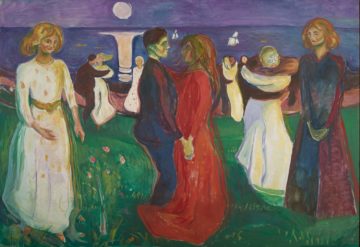
Originally published in the Marina Times San Francisco in June 2017
Self Portrait: Between the Clock and The Bed is a work conceived by Symbolist painter Edvard Munch between 1940 and 1943. A gaunt figure stares ahead absorbed in thought while standing between the comfort of his bed and a grandfather clock hiding behind the door like a ghost. This last significant self-portrait is the starting point of this exhibit’s examination of Munch’s career as an artist. Time, existence, love and death are just a few of Munch’s themes centered on the human condition, themes he rendered with a haunting originality that earned him a reputation as an innovator of 20th century figurative painting.
“When you consider that Munch felt that he didn’t really hit his stride until his 50’s and that his career doesn’t map against traditional paths of art history, then the latter part of his career warrants a closer look,” said Gary Garrels, Elise S. Haas Senior Curator of Painting and Sculpture at SFMOMA. Munch’s influence during the Symbolist and Expressionist era can be felt in the works of many 20th century artists who followed, in particular Jasper Johns who became interested in the cross hatch brushstrokes in Munch’s Self Portrait: Between the Clock and The Bed. Munch included the process of painting by allowing visceral scratchings of preliminary sketches to show through on the completed canvas. Sometimes utilizing heavily diluted oil paint or “turpentine painting”, Munch took a flat brush to create mysterious smoky glazes allowing the canvas surface to become a part of the final image in paintings such as Self-Portrait with Cigarette (1895). Another trademark of his style was the intense, vibrant colors used to depict emotion in works like The Dance of Life (1925).
Themes of anxiety, mortality, isolation and desire run through the 45 works in this exhibition, seven of which make their United States debut including Lady in Black (1891), Puberty (1894), Jealousy (1907), and Death Struggle (1915). Eight galleries unfold thematically, grouping Munch’s paintings according to subject matter. Many are deeply personal works from Munch’s own collection, on loan from the Munch Museum in Oslo, Norway along with other pieces borrowed from institutions and private lenders. In addition, SFMOMA will present Sick Mood at Sunset – Despair (1892), the earliest depiction and compositional genesis of Munch’s iconic painting The Scream, which is being shown outside of Europe for only the second time in its history.
Edvard Munch, throughout his career, challenged his own conclusions by reworking his subject matter and capturing emotion on canvas. Jon-Ove Steihaug, director of exhibitions and collections at the Munch Museum, said “Munch was an artist who never stopped looking.”